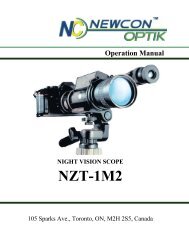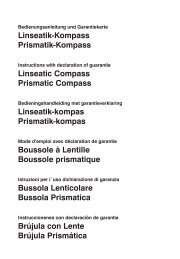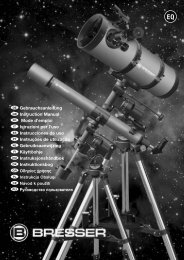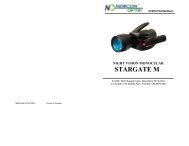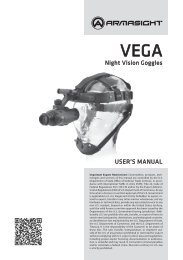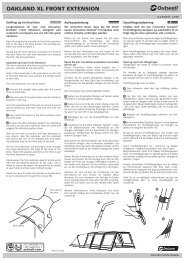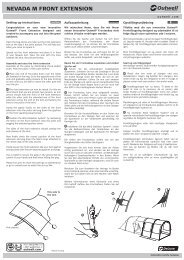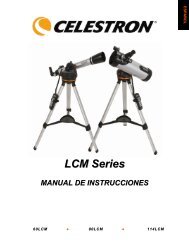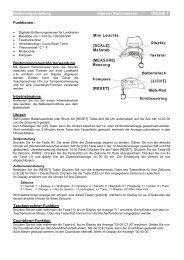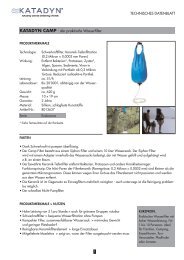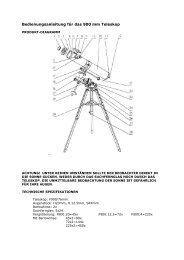Manual de instrucciones
Manual de instrucciones
Manual de instrucciones
You also want an ePaper? Increase the reach of your titles
YUMPU automatically turns print PDFs into web optimized ePapers that Google loves.
Part II – Handling<br />
1. Telescope mount:<br />
The following points of information are important for positioning<br />
and tracking accuracy of your telescope during night time<br />
observation.<br />
Your telescope has a so called equatorial mount. The main<br />
attribute of this mount is that it has two perpendicular axes<br />
which rotate to one another. (Fig 16, a+b).<br />
The so-called right ascension axis (or RA or axis of si<strong>de</strong>real time<br />
on the meridian) (illustration 16, b) must be aligned parallel to the<br />
earth's polar axis (illustration 26, c). The coordinates are found<br />
in e.g. celestial charts and programs.<br />
<strong>Manual</strong>ly operate the right ascension axis via the flexible shaft<br />
(illustration 1, 15) to constantly compensate for the earth's<br />
rotation by turning it in the opposite direction.<br />
As this axis must thus constantly be moved in a controlled<br />
manner using the flexible shaft an electric tracking accessory<br />
would be sensible (the necessary equipment for this is already<br />
installed - sh. parts - assembly)<br />
2. Setup:<br />
A dark place is essential for observations because light of all<br />
kinds (e.g. street lamps) disturb the visible <strong>de</strong>tails of the sky. If<br />
you leave a bright room at night, your eyes need approximately<br />
20 minutes to reach full night adaptation. After this time, your<br />
observations can be started.<br />
Don't observe from enclosed areas and put your telescope in<br />
location, with the accessories, 30 mins before beginning<br />
observation, in or<strong>de</strong>r to guarantee a temperature balance.<br />
You should also make sure that the telescope is placed on a<br />
stable and even ground.<br />
3. Balance:<br />
To avoid <strong>de</strong>mages from sensitive parts of the mount, the two<br />
axes must now be balanced before observation.<br />
I.e. the <strong>de</strong>clination axis and the horary axis are correct, to make<br />
working of the telescope easy and precise.<br />
The horary axis is balanced by loosening the fixing screws (Fig.<br />
16 I) and tilting the weight pole into a horizontal position. Now<br />
adjust the counterweight (Fig. 16 H) on the pole, until the tube<br />
and the weight remain in this horizontal position. Retighten the<br />
fixing screw (Fig. 16 I) on the horary axis.<br />
The <strong>de</strong>clination axis is balanced by loosening the fixing screw<br />
(Fig. 16 D) on the <strong>de</strong>clination axis. Then loosen the screws on<br />
the tube mounting (Fig. 16 A) and move the tube as long as it<br />
remains in a horizontal position. Don't forget to retighten the<br />
fixing screws again.<br />
4. Adjustment:<br />
To set the latitu<strong>de</strong> axis (illustration 16, F) (polar height) loosen the<br />
fixing screw (illustration 18, X) and adjust the polar height using<br />
the adjusting screw (illustration 18, Y).<br />
The latitu<strong>de</strong> scale has to be adjusted according the local latitu<strong>de</strong><br />
(e.g. Munich 48°, Hamburg 53°)<br />
Don’t forget to tighten the fixing screw afterwards. Now set the<br />
Declination axis (Fig. 16 C) to 90° by loosening and retightening<br />
the screw (Fig. 16 D). The telescope tube is now pointing to the<br />
celestial pole.<br />
HINT:<br />
The latitu<strong>de</strong> of your observation site can be found in<br />
maps or in the internet. A good source of information is<br />
www.heavens-above.com. After checking “anonymous<br />
user” > “select” you may choose your land and city.<br />
- 53 -<br />
5. Polar alignment<br />
Align the telescope with the barrel opening at the front to north.<br />
To do this loosen the fastening screw (illustration 19). You can<br />
then turn the barrel until it faces exactly northwards. If<br />
necessary, use a compass. Then tighten the fastening back up<br />
again.<br />
Examine whether your telescope is mounted as shown in Fig. 28.<br />
The counterweight (Fig. 28 X) points to the floor and makes<br />
together with the tube a vertical axis.<br />
In this position Polaris is visible in the viewfin<strong>de</strong>r; it is the<br />
brightest star in the polar region. If it is also be seen in the field<br />
of view of the 20 mm eyepiece, polar alignment is reached.<br />
This alignment requires little patience but results in accurate<br />
pointing.<br />
The <strong>de</strong>clination scale should now be set to “9” (90°). After doing<br />
this, you can use the <strong>de</strong>c. and R.A. scale to find celestial objects<br />
(also see part II – 13).<br />
Once adjusted as above you can utilise the celestial object<br />
search facility using the scales (see also 3.1. Feasible<br />
Observation Objects).<br />
6. Fin<strong>de</strong>r scope<br />
Your telescope is now roughly aligned and set.<br />
To arrive at a comfortable observation position carefully undo the<br />
main tube mounting screws (ill. 9, X) until you can rotate the telescope<br />
main tube. Move eyepiece and fin<strong>de</strong>r scope/LED fin<strong>de</strong>r<br />
scope until the position is comfortable for you.<br />
Fine adjustment is done with the aid of the fin<strong>de</strong>r scope. Look<br />
through the fin<strong>de</strong>r scope and try to align it with the polar star (ill.<br />
27) in the centre of the crosshairs (ill. 31). In precisely adjusting<br />
your telescope you will find the shaft (ill. 16, K) of the hour axis<br />
(ill. 16, b) and that (ill. 16, E) of the <strong>de</strong>clination axis (ill. 16, a) helpful.<br />
7. Observation<br />
Once you have set the polar star in your fin<strong>de</strong>r scope/LED fin<strong>de</strong>r<br />
scope you will be able to view it through your telescope eyepiece.<br />
If necessary, you can with help of the flexible handles align the<br />
star more exactly, just as you can adjust the <strong>de</strong>finition by using<br />
the focussing wheel (Fig. 16 B).<br />
Furthermore, you can now, by changing the eyepiece, increase<br />
the magnification. Note that the magnification of the stars can<br />
hardly be seen.<br />
HINT:<br />
Eyepieces enlarge the (not directly visible) picture of<br />
the telescope’s prime focus. The less the eyepiece’s<br />
focal lengths is, the stronger is the magnification. So<br />
various eyepieces are nee<strong>de</strong>d to reach different magnifications.<br />
Begin every observation with a low magnification<br />
(20mm eyepiece).<br />
8. Find a star:<br />
Initially it will be difficult for you to find your bearings in the<br />
firmament, since the stars and the constellations are always<br />
moving and according to season, date and time their position in<br />
the heavens will change. The pole star is the exception. It is a<br />
fixed star and the starting point for all star maps.<br />
At the beginning, you should look at some well known<br />
constellations and star groups or<strong>de</strong>r that are visible the whole<br />
year over. The position of the heavenly bodies is however<br />
<strong>de</strong>pen<strong>de</strong>nt on date and time.<br />
If you have aligned your telescope accurately on one of these<br />
stars, you will find that it has vanished your visual field after a<br />
few minutes. To even out this effect, you must turn the<br />
flexible handle (Fig. 16 K) the horary axis and your telescope will<br />
follow the trajectory of this star.<br />
GB



